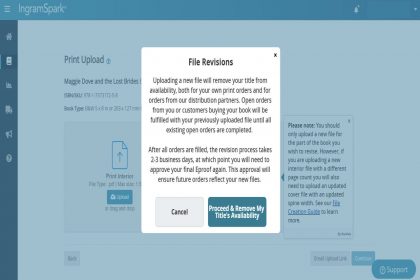
So you’ve written your masterpiece, edited it, and had a professional cover designed. You’re super stoked to share it with the world, but you’ve shot your wad getting it this far and you have no idea how you’re going to pay for its printing, shipping and marketing. What to do?
Why not run a crowdfunding campaign?
What is crowdfunding and how does it work?
Crowdfunding is, as the name suggests, a method of funding your project using the crowd’s—other people’s—money (OPM).
There are a number of different platforms that you can use to gather OPM, including everything from holding up a cup and a cardboard sign outside of Starbucks to using an online service like:
While there are benefits unique to each platform, the one I utilized for my book launch was Kickstarter. As such, that’s the one I will focus on here (but you can research all the available services by visiting the resource links at the end of this article).
Getting Started with Kickstarter
The first step in crowdfunding a book
(Or, as I like to call it, crowdwhaling—you know, fishing for the great white whale known as OPM) is to determine how much money you’ll need to reach your goal.
In my case, I knew I wanted enough cash to cover the cost of printing 150 copies of my book in hardcover and paperback. I also wanted enough to pay for shipping, contest entry fees and to hire New Shelves to help me market the book. So, crunching the numbers I settled on $8,700.
Note: When setting your goal make sure you account for Kickstarter’s fees of 8-10%.
Next, you’ll need to enter your project’s basic info:
- Title /subtitle:
-
- I just used the title of my book, but you can be creative here (e.g., Joe’s Author Dream, or Joanne’s First Book…okay, not so creative).
-
- Category: Pretty self-explanatory, just be sure to be as precise as possible—you don’t want your poetry book to be entered in the Fashion/Footwear category.
-
- Location: Not sure how important this is, but it would make sense to enter your hometown. You never know who might be looking to support a local artist.
-
- Image: Here’s where your project gets its first chance to sell itself. For the image, I recommend using your book’s cover if it was professionally done. If not, you can still use it, but my question to you is: why are you cutting corners on the one piece of the publishing puzzle that carries greater than or equal to (> for all you math geeks) weight as the writing of the book itself? 5
-
- Video: Awww, do I have to I hear you asking. Yes.Projects with video have a much better chance of funding than those without. In fact, 80% of successful Kickstarter campaigns have a video.What you include is entirely up to you. For mine, I mentioned why this project meant so much to me, I read some poems from the manuscript and then I thanked the viewer for their support.
Note: I believe it’s important to be sincerely grateful to your supporters and to express that gratitude in your video. Fail to do this at your own peril.
- Video: Awww, do I have to I hear you asking. Yes.Projects with video have a much better chance of funding than those without. In fact, 80% of successful Kickstarter campaigns have a video.What you include is entirely up to you. For mine, I mentioned why this project meant so much to me, I read some poems from the manuscript and then I thanked the viewer for their support.
- Launch date/duration: You have the option of selecting a predetermined date to launch your campaign at some point in the future, or you can leave this blank and just launch when you’re ready.As for the duration, you can choose to run the campaign for 1-60 days and, while it may seem like a longer duration is better, that’s actually incorrect. Per the Kickstarter site, “We limit campaigns to 60 days and recommend 30 days or less. The limited time period creates urgency and motivates your community to back your project and spread the word.” I ran mine for just over three weeks and would, for all future campaigns, probably limit the duration to 21 days max.
With most of the hard stuff out of the way, your next step is to pick your rewards.
These are the physical benefits that you are offering to your backers in exchange for their contribution.
You’ll want to have a variety of reward levels (3-10 should be fine), geared toward those small and big donors alike. Here’s another chance to flex your creative genius. You can offer anything your mind can conceive as enticement for the elusive OPM, just be sure you’ll be able to fulfill the item when your campaign has ended.
Note: Be creative when titling your rewards. Don’t just label them Backer Group 1, Backer Group 2, etc. (Here are the ones I used.) 6
Next, you’ll want to create a compelling story about your project.
Give potential donors a reason to support this project, RIGHT NOW!
Remember, you are competing against every other potential use of OPM so you’ll want to craft an interesting, heartfelt tale about what you’re raising the money for, why now is the right time and, perhaps most importantly, why this project means so much to you.
The next couple steps, your bio and bank info, are pretty straight forward.
Note: Just remember that when you’re writing your bio, don’t be humble.
If you’ve won an award, been written up in a major publication or have just read every known book on your subject (or in your genre), make sure you note it here. Your friends love hearing about your little victories and most donors are happy to share in your accomplishments, if only you’ll let them.
The final step, Promotion, is undoubtedly the most difficult and stress inducing to the majority of Kickstarter newbies.
I say this because Kickstarter is an all-or-nothing platform, meaning you either hit 100% of your goal or you pack it in and try again later. There are no moral victories, no participation trophies. You either earn your money or you don’t. As such, let me share with you what worked for me.
- Do set a reasonable (but ambitious) goal.
- Don’t expect Kickstarter to funnel donors your way. Instead, do tap your contacts (your sphere of influence, or SOI) starting with your closest friends and family and work your way out from there.
- Do be considerate of your SOI’s time when reaching out. Don’t bombard them with countless, lengthy emails/texts.
- That said, don’t rely on just email or just text and don’t expect your SOI to act after just one message. Do have a template text/email/phone pitch at the ready and be sure to follow up with your contacts by any/all means necessary until they donate or say no thanks.
- Do acknowledge that times are tough right now and that you understand if your SOI is not able to help the cause. Don’t get discouraged/angry/upset when your best friends say “Thanks, but no.”
- Don’t get complacent if you’re on target early on. Do understand that this is a marathon, not a sprint. As such, do plan on dripping on your contact list daily until you’ve hit your goal.
- Do consider advertising your Kickstarter campaign using Krowdster’s proprietary tools. 7
- Don’t expect that strategy to pay huge dividends.Note: The best source of OPM is always your SOI, so don’t be bashful when promoting your project. Tell your mama, papa, brother, sister, cousin-once-removed. Tell your accountant, attorney, your doctor. Tell EVERYONE about your project. You’d be surprised how many people want to see you succeed.
- Don’t rely solely on Social Media (SM) to spread the word. But do ask your friends and family to share a link to your project on their SM pages. This will increase the reach of your message exponentially.
- Do follow through on fulfillment. If you said you would ship an inscribed, signed & numbered copy of your book to Backer Group 1 (please, for the love of God, don’t call them Backer Group 1) by XYZ date, then be sure to ship an inscribed, signed & numbered copy of your book to Backer Group 1 by XYZ date.
Summary
Crowdfunding can be a great way to bridge the financial gap between completed manuscript and award-winning (and dare we dream, bestselling) published book.
Hopefully, you now feel empowered to utilize Kickstarter or another crowdfunding application in pursuit of OPM. If not, feel free to reach out with any questions.
Randall McNair is the award winning author of the Bar Poems series. His first book, Dispatches from the Swinging Door Saloon was made possible by the generous donations to his own Kickstarter campaign by his tight knit sphere of influence. The campaign funded at 115% of his goal, finishing in the top 45 most funded poetry projects on the Kickstarter platform.8 The funds raised have helped keep Dispatches on the top 100 list of numerous categories at Amazon.com, as well as earning it a Gold Book Award from Literary Titan. You can grab a copy at barpoems.com or take 20% off your entire order when you enter coupon code NewShelves20 at his webpage: mcnairpoet.com.
Resources
1Kickstarter
2How GoFundMe Works
3Patreon for Writers & Journalists
4Indiegogo
5 13 Questions to Ask When Designing a Book Cover
6Dispatches From The Swinging Door Saloon
7Krowdster
8Kickstarter – “Show me poetry projects in Poetry on Earth sorted by Most Funded”





[…] launch? First, if you’re looking for more information on crowd funding a book project, check out this New Shelves guest blog from Randall McNair. Then to the question of timing: There are no hard and fast rules for how early […]